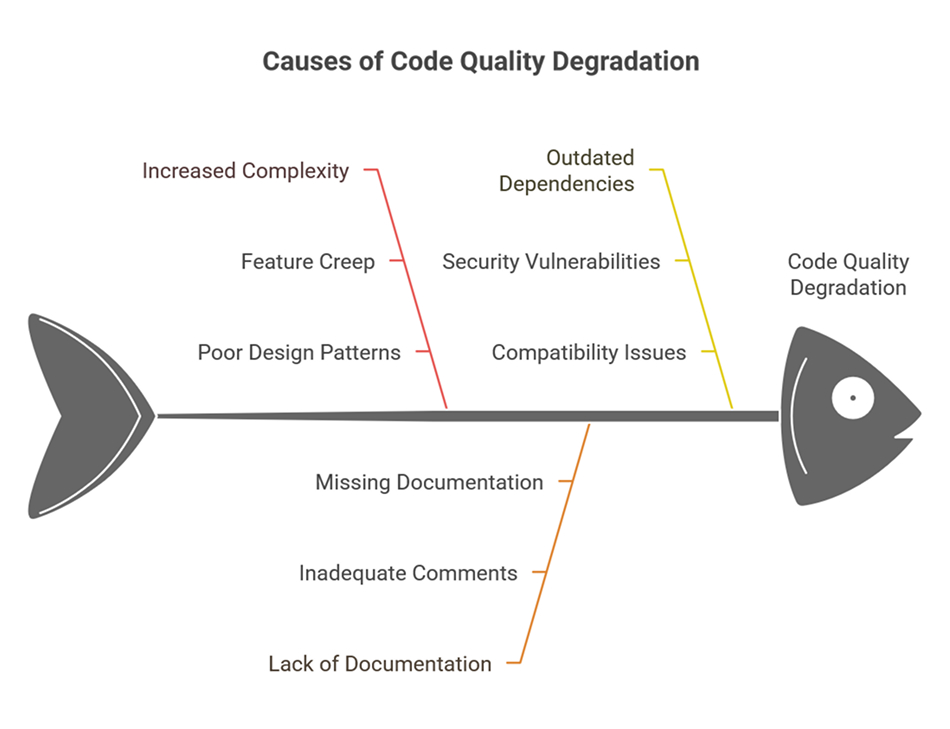Code rot occurs when a codebase becomes messy and harder to work with over time. This usually happens when updates and bug fixes keep getting added without cleaning up the overall structure. As a result, the code gets more complicated, making it tricky to maintain. Over time, as requirements and dependencies change, the design might not keep up, leading to confusing code and hidden issues.
You can measure code rot using software metrics like cyclomatic complexity, code churn, and cycle time. If these numbers keep going up, it’s usually a sign that the code is getting more complicated and harder to manage.
Another red flag is when the documentation doesn’t match how the code actually works. Outdated or missing docs force developers to figure things out the hard way—by digging through the code themselves.
Essentially, code rot happens when quick fixes and old code pile up, creating technical debt. It also occurs when coding practices don’t keep up with modern development standards, making the codebase harder to maintain.
Recognizing Code Rot
Spotting software entropy in a codebase means looking for signs that the code is getting messy and harder to manage. One big red flag is unused or redundant code. This includes old functions that aren’t used anymore or conditional branches that never actually run. For example, leftover code from deprecated APIs or outdated feature toggles just adds clutter, making maintenance harder and increasing the risk of accidentally breaking something if it gets reactivated.
Another sign is when the code becomes harder to read and maintain. If it has gone through too many unorganized changes, it starts losing clarity, making even small updates risky. This often leads to fragile code, where one minor change can cause unexpected problems elsewhere. You can see this happening when metrics like cyclomatic complexity and code churn start climbing.
Outdated or inconsistent documentation is another problem. When comments, API docs, or architectural diagrams don’t match the actual code, developers have to figure things out on their own, which wastes time and increases errors.
Software rot generally falls into two categories:
- Active code rot: Occurs when continuous modifications, bug fixes, and feature additions gradually erode the code’s design integrity.
- Dormant code rot: Manifests in legacy sections of the code that are seldom updated, causing them to fall behind modern architectural practices and compatibility standards.

Consequences of Code Rot
Code rot introduces several technical challenges that can impact both system reliability and development efficiency. As a codebase deteriorates, these issues not only affect software quality in the short term but also make long-term maintenance and scalability significantly more difficult.
Key technical consequences include:
- Increased defect density:
- Higher complexity and redundant code paths create more opportunities for bugs to emerge.
- Frequent modifications (code churn) can unintentionally introduce new defects.
- Slower development cycle:
- Developers spend more time deciphering poorly structured or undocumented code.
- A fragile codebase increases the likelihood of unexpected issues arising from even minor changes.
- Reduced maintainability and scalability:
- Accumulated technical debt makes ongoing maintenance increasingly complex and resource-intensive.
- Legacy components that are not regularly refactored may become incompatible with modern frameworks, libraries, or hardware.
Strategies for Mitigating Code Rot
Here are some key strategies to keep your codebase clean, stable, and easy to maintain:
- Automated testing and CI/CD integration
- Implement unit, integration, and regression tests to catch issues early and prevent unintended side effects.
- Automate quality checks like static analysis and code coverage through CI/CD pipelines to ensure new changes don’t introduce technical debt.
- Regular refactoring:
- Schedule periodic reviews and refactoring sessions to simplify logic, eliminate redundant code, and reduce complexity.
- Instead of large-scale rewrites, apply small, continuous improvements to maintain stability while enhancing code quality.
- Monitoring and managing software metrics:
- Measure cyclomatic complexity, code churn, and cycle time to identify areas that need attention.
- Use automated tools to flag complexity spikes and enforce best practices before issues accumulate.
- Standardized coding guidelines and best practices:
- Establish and follow clear guidelines to make the codebase more readable, maintainable, and uniform.
- Leverage automated tools to catch code quality issues early and maintain consistency across the team.
- Developer onboarding and continuous learning:
- Offer training on coding best practices, design patterns, and refactoring techniques.
- Foster a culture of knowledge sharing, where developers learn from each other and collectively improve code quality.
Conclusion
Code rot slowly erodes software quality, making it harder to maintain and scale over time. But with the right approach-automated testing, regular refactoring, and continuous monitoring-we can keep our code clean, efficient, and easy to work with. By staying proactive, we ensure a healthier codebase and a smoother development process.
